 | |
| Type | Satellite television network |
|---|---|
| Country | Iraq |
| Ownership | |
| Owner | Iraqi Islamic Party |
| Links | |
| Website | www |
Baghdad Satellite Channel is a terrestrial television network in Iraq. [1] [2] [3]
 | |
| Type | Satellite television network |
|---|---|
| Country | Iraq |
| Ownership | |
| Owner | Iraqi Islamic Party |
| Links | |
| Website | www |
Baghdad Satellite Channel is a terrestrial television network in Iraq. [1] [2] [3]

Baghdad is the capital of Iraq and the second-largest city in the Arab world after Cairo. It is located on the Tigris river. In 762 CE, Baghdad was chosen as the capital of the Abbasid Caliphate, and became its most notable major development project. Within a short time, the city evolved into a significant cultural, commercial, and intellectual center of the Muslim world. This, in addition to housing several key academic institutions, including the House of Wisdom, as well as a multiethnic and multi-religious environment, garnered it a worldwide reputation as the "Center of Learning".

Iraq is a country in Western Asia that largely corresponds with the territory of ancient Mesopotamia. The history of Mesopotamia extends from the Lower Paleolithic period until the establishment of the Caliphate in the late 7th century AD, after which the region came to be known as Iraq. Encompassed within Iraqi territory is the ancient land of Sumer, which came into being between 6000 and 5000 BC during the Neolithic Ubaid period of Mesopotamian history, and is widely considered the oldest civilization in recorded history. It is also the historic center of the Akkadian, Neo-Sumerian, Babylonian, Neo-Assyrian, and Neo-Babylonian empires, a succession of local ruling dynasties that reigned over Mesopotamia and various other regions of the Ancient Near East during the Bronze and Iron Ages.
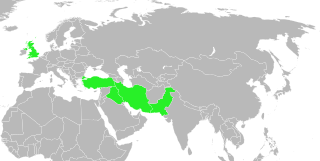
The Central Treaty Organization (CENTO), formerly known as the Middle East Treaty Organization (METO) and also known as the Baghdad Pact, was a military alliance of the Cold War. It was formed on 24th February, 1955 by Iran, Iraq, Pakistan, Turkey, and the United Kingdom. The alliance was dissolved on 16 March 1979.
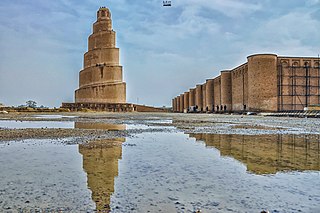
Samarra is a city in Iraq. It stands on the east bank of the Tigris in the Saladin Governorate, 125 kilometers (78 mi) north of Baghdad. The modern city of Samarra was founded in 836 by the Abbasid caliph al-Mu'tasim as a new administrative capital and military base. In 2003 the city had an estimated population of 348,700. During the Iraqi Civil War, Samarra was in the "Sunni Triangle" of resistance.
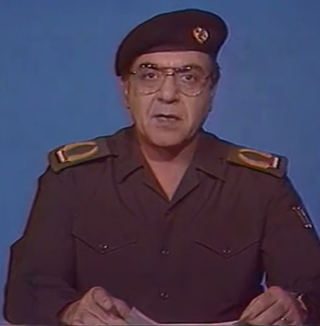
Mohammed Saeed al-Sahhaf (Arabic: محمد سعيد الصحاف Muḥammad Saʿīd Al-Ṣaḥḥāf; is an Iraqi former diplomat and politician. He served as Minister of Foreign Affairs from 1992 to 2001. He came to worldwide prominence around the 2003 invasion of Iraq, during which he was the Minister of Information under Iraqi President Saddam Hussein, acting as spokesman for the Arab Socialist Ba'ath Party and Saddam's government. He has also been nicknamed Baghdad Bob or Comical Ali for his notable and colorful television appearances as the Information Minister of Iraq.

Muhammad Naji Shawkat Bey was an Iraqi politician who served as the prime minister of Iraq under King Faisal I.

The music of Iraq or Iraqi music,, also known as the music of Mesopotamia, encompasses the music of a number of ethnic groups and musical genres. Ethnically, it includes Mesopotamian Arabic, Assyrian, Kurdish and the music of Turkmen, among others. Apart from the traditional music of these peoples, Iraqi music includes contemporary music styles such as pop, rock, soul and urban contemporary.

Iraqi Kurdistan or Southern Kurdistan refers to the Kurdish-populated part of northern Iraq. It is considered one of the four parts of "Kurdistan" in Western Asia, which also includes parts of southeastern Turkey, northern Syria, and northwestern Iran. Much of the geographical and cultural region of Iraqi Kurdistan is part of the Kurdistan Region (KRI), an autonomous region recognized by the Constitution of Iraq. As with the rest of Kurdistan, and unlike most of the rest of Iraq, the region is inland and mountainous.

Farhud was the pogrom or the "violent dispossession" that was carried out against the Jewish population of Baghdad, Iraq, on June 1–2, 1941, immediately following the British victory in the Anglo-Iraqi War. The riots occurred in a power vacuum that followed the collapse of the pro-Nazi government of Rashid Ali while the city was in a state of instability. The violence came immediately after the rapid defeat of Rashid Ali by British forces, whose earlier coup had generated a short period of national euphoria, and was fueled by allegations that Iraqi Jews had aided the British. More than 180 Jews were killed and 1,000 injured, although some non-Jewish rioters were also killed in the attempt to quell the violence. Looting of Jewish property took place and 900 Jewish homes were destroyed.

The history of the Jews in Iraq is documented from the time of the Babylonian captivity c. 586 BCE. Iraqi Jews constitute one of the world's oldest and most historically significant Jewish communities.

The Vilayet of Baghdad was a first-level administrative division (vilayet) of the Ottoman Empire in modern-day central Iraq. The capital was Baghdad.
Jupiter Airlines was an airline based in Sharjah, United Arab Emirates. The carrier initially served domestic routes within the United Arab Emirates, but has added various key cities in the Middle East to its list of destinations. In December 2004, the airline launched a service between Dubai and Baghdad (Iraq). On February 25, 2009, Jupiter Airlines launched a service between Dubai and Mosul, Iraq. There was also a service between Dubai and Basra.
New Baghdad or Baghdad Al-Jidida is one of nine administrative districts in Baghdad, Iraq. This district has nine Neighborhood Advisory Councils (NAC) and a District Advisory Council. It is located east of the city center. This district was renamed 9 Nissan or Tisa Nissan. Nissan is the word for April, although most Iraqis do not yet use that name. It is also known as 7 Nissan.
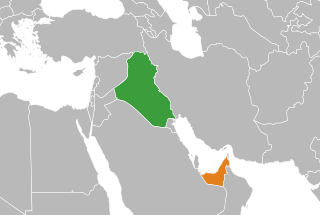
Iraqi-Emirati relations are foreign relations between the Republic of Iraq and the United Arab Emirates. Iraq has an embassy in Abu Dhabi and a consulates general in Dubai, while the United Arab Emirates has an embassy in Baghdad.

Basra Eyalet was an eyalet of the Ottoman Empire. Its reported area in the 19th century was 9,872 square miles (25,570 km2). It had a Defterdar and Kehiya of the Chavushes but neither Alai-beg nor Cheribashi because there were no ziamets or Timars, the lands being all rented by the governor.
The 23 February 2012 Iraq attacks were the fifth simultaneous wave of bombings to hit Iraq during the insurgency and the first such major assault since the US withdrawal at the end of 2011. At least 83 people were killed and more than 250 wounded in highly coordinated attacks spread out in least 15 cities - including at least 10 explosions in the capital Baghdad that left 32 people dead. A number of shootings also took place, mostly aimed at police patrols and security installations around the city. The majority of the blasts appeared to specifically target Shiite areas.

Al-Rahman Mosque in Baghdad, was intended to be one of the largest mosques in Iraq. It was begun by Saddam Hussein in 1998, but work was cut short during the 2003 invasion of Iraq and it was never completed and only its skeleton remains today. It remains uncompleted in Baghdad's Mansour neighbourhood, in the place of the old race track. Its main, uncompleted dome, is surrounded by eight smaller, independent domes, which in turn feature eight even smaller domes integrated into their walls. It is approximately 250 metres (820 ft) in diameter, and occupies 4.5 hectares.
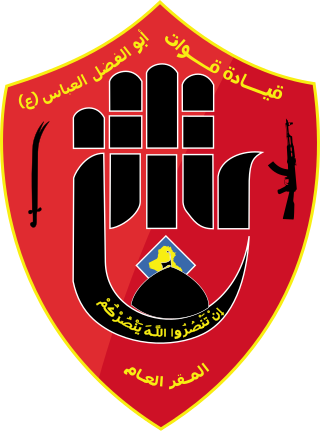
Abu al-Fadl al-Abbas Forces, officially named the Qaeda Quwwat Abu Fadl al-Abbas, is a Shiite militia operating in Iraq, formed following the June 2014 ISIL advances. The force is affiliated with Sheikh Aws al-Khafaji, who was previously aligned with Muqtada al-Sadr. The group claims an affinity with the similarly named Liwa Abu al-Fadhal al-Abbas group fighting in Syrian Civil War on behalf of the Syrian government. QQAFA also appears to have deep links to Kataib al-Imam Ali.

The Haydar-Khana Mosque is a historic mosque located near al-Mutanabbi Street in Baghdad, Iraq, built by al-Nasir during the Abbasid Caliphate. The mosque is situated on al-Rasheed Street and is located in the Haydar-Khana locality surrounded by buildings, shrines, and cafés.

A series of demonstrations, marches, sit-ins and civil disobedience took place in Iraq from 2019 until 2021. It started on 1 October 2019, a date which was set by civil activists on social media, spreading mainly over the central and southern provinces of Iraq, to protest corruption, high unemployment, political sectarianism, inefficient public services and foreign interventionism. Protests spread quickly, coordinated over social media, to other provinces in Iraq. As the intensity of the demonstrations peaked in late October, protesters’ anger focused not only on the desire for a complete overhaul of the Iraqi government but also on driving out Iranian influence, including Iranian-aligned Shia militias. The government, with the help of Iranian-backed militias responded brutally, using live bullets, marksmen, hot water, hot pepper gas and tear gas against protesters, leading to many deaths and injuries.